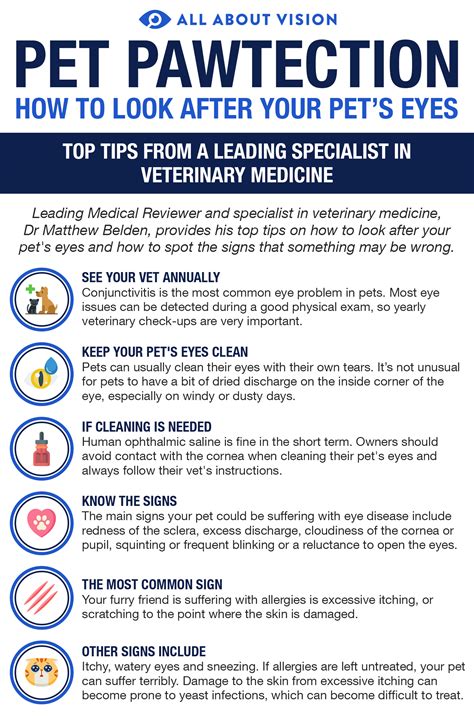Introduction
Our furry companions rely on their eyes to experience the world around them. As responsible pet owners, it’s crucial to prioritize their eye health and well-being. Here are five essential eye care tips to keep your pet’s peepers healthy and happy in 2025:

1. Regular Eye Check-ups
According to the American Veterinary Medical Association (AVMA), annual eye check-ups are a vital component of preventive pet care. These routine check-ups allow veterinarians to assess your pet’s eye health, detect potential problems early on, and recommend appropriate treatments if necessary.
2. Daily Cleaning and Inspection
Just like our own eyes, pet eyes can accumulate debris, dust, and mucus over time. Regular cleaning can help prevent irritation, infections, and other eye-related issues. Use a soft, damp cloth or cotton ball to gently wipe away any discharge or debris. Be sure to inspect your pet’s eyes daily for any signs of redness, swelling, or discharge.
3. Protection from Irritants
Pets are curious creatures and often expose their eyes to various irritants, such as smoke, dust, and chemicals. When possible, try to minimize your pet’s exposure to these irritants to protect their delicate eyes. If you’re using cleaning products or gardening chemicals, keep them out of your pet’s reach.
4. Proper Nutrition
A balanced diet plays a crucial role in maintaining overall pet health, including eye health. Vitamin A, for example, is essential for proper vision. Make sure your pet’s diet provides adequate amounts of vitamins, minerals, and antioxidants to support healthy eyes.
5. Breed-Specific Considerations
Some breeds of dogs and cats are more prone to certain eye conditions due to their genetics. For instance, brachycephalic (flat-faced) breeds like Bulldogs and Pugs are more likely to experience eye issues such as proptosis (bulging eyes) and corneal ulcers. Familiarize yourself with any breed-specific eye conditions that your pet may be susceptible to.
Common Mistakes to Avoid
While caring for your pet’s eyes, there are a few mistakes to steer clear of:
- Neglecting regular eye check-ups: Skipping annual eye exams can lead to undetected eye problems that could escalate into more serious issues.
- Using human medications: Never use human eye drops or medications on your pet without consulting a veterinarian. These products may contain ingredients that are harmful to animals.
- Over-cleaning: While it’s important to clean your pet’s eyes regularly, over-cleaning can irritate the delicate tissues.
- Using harsh chemicals: Avoid using harsh cleaners or chemicals around your pet’s eyes. These substances can cause irritation or even burns.
- Ignoring signs of eye problems: If you notice any abnormalities in your pet’s eyes, such as redness, discharge, or squinting, don’t ignore them. Consult with a veterinarian immediately.
Innovations in Pet Eye Care
Advancements in veterinary medicine are leading to innovative solutions for pet eye care. Some emerging trends include:
- Non-invasive diagnostics: Telemedicine and teleophthalmology allow veterinarians to remotely diagnose and monitor eye conditions using high-tech imaging tools.
- Stem cell therapy: Stem cell transplantation offers promising treatments for certain eye diseases in pets, restoring damaged tissues and improving vision.
- Artificial intelligence (AI): AI-powered systems are being developed to detect and analyze eye conditions with greater accuracy and efficiency, aiding veterinarians in providing more precise diagnoses.
Table 1: Eye Health Statistics
| Statistic | Source |
|---|---|
| 50% of dogs will develop an eye condition in their lifetime | American Kennel Club |
| 20% of cats will experience eye problems by age 10 | Cornell University College of Veterinary Medicine |
| Nearly 2 million pets in the United States go blind each year | Humane Society International |
Table 2: Common Eye Conditions in Pets
| Condition | Symptoms | Treatment |
|---|---|---|
| Cataracts | Clouding of the lens | Surgery |
| Glaucoma | Increased pressure in the eye | Medication, surgery |
| Conjunctivitis (pink eye) | Inflammation of the conjunctiva | Antibiotics, eye drops |
| Corneal ulcers | Open sores on the cornea | Eye drops, antibiotics |
| Entropion | Inward rolling of the eyelid | Surgery |
Table 3: Breed-Specific Eye Conditions
| Breed | Common Eye Conditions |
|---|---|
| Bulldog | Entropion, proptosis, keratoconjunctivitis sicca (dry eye) |
| Poodle | Progressive retinal atrophy, cataracts |
| Siberian Husky | Corneal dystrophy, glaucoma |
| Golden Retriever | Glaucoma, cataracts |
| Siamese cat | Amyloidosis (deposits of amyloid protein in the cornea) |
Table 4: Prevention Tips for Eye Problems
| Tip | Benefits |
|---|---|
| Regular eye check-ups | Early detection and treatment of eye conditions |
| Daily cleaning and inspection | Prevention of irritation and infections |
| Protection from irritants | Minimizes exposure to harmful substances |
| Proper nutrition | Supports overall eye health and vision |
| Breed-specific considerations | Awareness of potential genetic eye issues |
Conclusion
The health and happiness of our beloved pets depend on our vigilance and care. By following these five essential eye care tips, you can ensure your furry companion enjoys a clear and healthy vision for years to come. Remember, regular eye check-ups, daily cleaning, protection from irritants, proper nutrition, and breed-specific considerations are key to maintaining optimal eye health. As veterinary medicine continues to advance, innovative technologies and therapies offer promising solutions for pet eye care, giving our furry friends a brighter future.





















